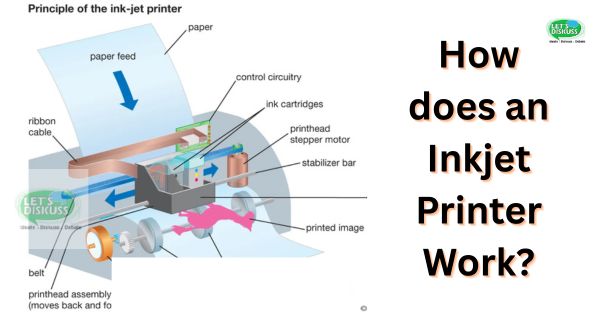university.nakul@gmail.com | Posted on
An inkjet printer is an extremely commonly used and highly popular machine that performs exceptionally well at printing high-quality text as well as stunning images on various types of paper. The fundamental operating mechanism of this wonderful machine relies on the precise and accurate deposition of minute droplets of liquid ink on the paper surface by a highly intricate and sophisticated system for this very purpose. In the following paragraphs, you will learn a complete and comprehensive explanation of the mechanisms involved in the operation of an inkjet printer:
Basic Components of an Inkjet Printer
-
Print Head: This is the heart of the printer, which directs the ink onto the paper. It has very small nozzles, through which the ink comes out.
-
Ink Cartridges: These hold the liquid ink, dye-based or pigment-based, in separate cartridges for different colors—most commonly cyan, magenta, yellow, and black (CMYK).
-
Stepper Motors: Stepper motors control the motion of the print head and paper, thus providing precise positioning during printing.
-
Paper Feed System: The paper feed mechanism has rollers that pull the paper into the printer and push it through the print head.
-
Control Circuitry: A microprocessor decodes received data from a computer or peripheral device and operates the print head, paper passage, and flow of ink accordingly.
Working Principle of Inkjet Printing
Inkjet printing involves spraying minuscule droplets of ink onto paper to recreate digital images or text. The two primary technologies used to eject ink are thermal bubble and piezoelectric methods. Both techniques achieve similar results but differ in their mechanisms.

1. Thermal Bubble Technology
This method is applied widely in printers by companies such as HP and Canon. Here is how it works:
-
A heating device within the print head vaporizes the ink at temperatures over 300°C, making the ink turn into a bubble.
-
It expands and it forces a small drop of ink out of the nozzle and onto paper.
-
When the bubble bursts, a vacuum is created which pulls more ink into the nozzle from the cartridge.
-
This is repeated thousands of times per second to produce high-resolution prints.
2. Piezoelectric Technology
This specific technique, utilized by Epson and a few other companies, relies on piezoelectric crystals:
-
There is a piezoelectric crystal behind every nozzle. The crystal changes shape when there is an electrical current fed into it.
-
This deformation forces an ink droplet out of the nozzle and onto paper.
-
The crystal goes back to its initial form, sucking in more ink into the nozzle for the subsequent droplet.
The piezoelectric process is more effective than the thermal bubble process because it can be used at lower temperatures, which minimizes component wear and enables a greater variety of ink types to be used.
Color Mixing and Layering
To produce a range of colors, inkjet printers use the CMYK color model. By careful mixing of the four basic colors in varying proportions and their careful layering, the printer can produce millions of colors. For printing in black and white, the black cartridge is used.
Resolution and Accuracy
Inkjet printers are defined by their resolution, in dots per inch (DPI). The extremely narrow nozzles within the print head can dispense one-tenth of the thickness of a human hair in ink droplets, thus forming highly detailed subtleties and smooth color transitions.
Paper Feeding and Print Head Movement
-
The paper feeding mechanism provides paper to be fed to the printer on an individual sheet basis.
-
The print head travels horizontally across the paper in a back-and-forth manner, while the paper travels vertically in tiny steps following each pass of the print head. The simultaneous travel allows for the coating of the entire surface of the paper with ink.
Advantages of Inkjet Printing
-
Produces high-quality prints with excellent color accuracy.
-
Affordable and easily accessible for home and office use.
-
Able to print onto a variety of media including transparencies and photograph paper.
Maintenance
Inkjet printers require regular cleaning to prevent clogging of the nozzles. Many models include automated cleaning cycles to maintain performance.
In brief, an inkjet printer operates through careful and precise control of the ejection of small droplets of ink onto a sheet of paper by means of highly developed and advanced technologies. This wonderful ability to make prints that are clear and colored makes it the preferred choice for a variety of applications, ranging from routine document printing tasks to the more specialized field of professional photography.
0
0 Comment
